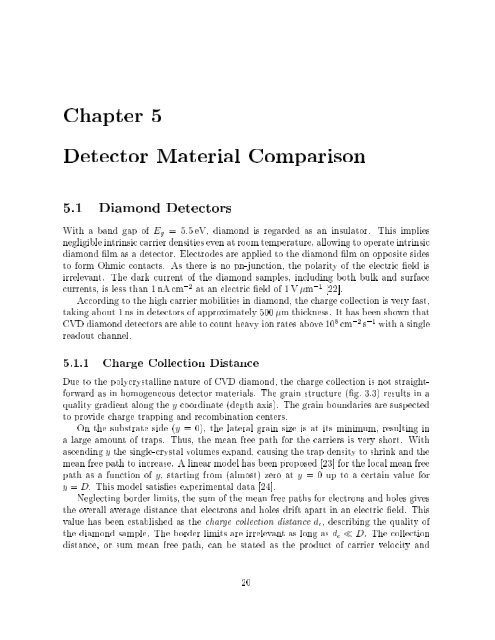Diamond Detectors for Ionizing Radiation - HEPHY
Diamond Detectors for Ionizing Radiation - HEPHY
Diamond Detectors for Ionizing Radiation - HEPHY
You also want an ePaper? Increase the reach of your titles
YUMPU automatically turns print PDFs into web optimized ePapers that Google loves.
Chapter 5<br />
Detector Material Comparison<br />
5.1 <strong>Diamond</strong> <strong>Detectors</strong><br />
With a band gap of E g = 5:5eV, diamond is regarded as an insulator. This implies<br />
negligible intrinsic carrier densities even at room temperature, allowing to operate intrinsic<br />
diamond lm as a detector. Electrodes are applied to the diamond lm on opposite sides<br />
to <strong>for</strong>m Ohmic contacts. As there is no pn-junction, the polarity of the electric eld is<br />
irrelevant. The dark current of the diamond samples, including both bulk and surface<br />
currents, is less than 1 nA cm ,2 at an electric eld of 1 V m ,1 [22].<br />
According to the high carrier mobilities in diamond, the charge collection is very fast,<br />
taking about 1 ns in detectors of approximately 500 m thickness. It has been shown that<br />
CVD diamond detectors are able to count heavy ion rates above 10 8 cm ,2 s ,1 with a single<br />
readout channel.<br />
5.1.1 Charge Collection Distance<br />
Due to the polycrystalline nature of CVD diamond, the charge collection is not straight<strong>for</strong>ward<br />
as in homogeneous detector materials. The grain structure (g. 3.3) results in a<br />
quality gradient along the y coordinate (depth axis). The grain boundaries are suspected<br />
to provide charge trapping and recombination centers.<br />
On the substrate side (y = 0), the lateral grain size is at its minimum, resulting in<br />
a large amount of traps. Thus, the mean free path <strong>for</strong> the carriers is very short. With<br />
ascending y the single-crystal volumes expand, causing the trap density to shrink and the<br />
mean free path to increase. A linear model has been proposed [23] <strong>for</strong> the local mean free<br />
path as a function of y, starting from (almost) zero at y = 0 up to a certain value <strong>for</strong><br />
y = D. This model satises experimental data [24].<br />
Neglecting border limits, the sum of the mean free paths <strong>for</strong> electrons and holes gives<br />
the overall average distance that electrons and holes drift apart in an electric eld. This<br />
value has been established as the charge collection distance d c , describing the quality of<br />
the diamond sample. The border limits are irrelevant as long as d c D. The collection<br />
distance, or sum mean free path, can be stated as the product of carrier velocity and<br />
20












